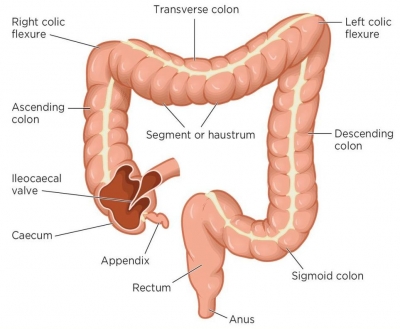
Up, across, and down
The large intestine is a wide tube that goes around the small intestine. The tube goes up. across the abdomen, then down again. It has a lumpy appearance because of the way the muscles in its wall contract.
Transverse colon
Passing just below the stomach, this is the middle part of the large intestine. It extends between the right and left colic (splenic) flexures, spanning the right hypochondriac, epigastric and left hypochondriac regions of the abdomen.
Ascending colon
On the right side of the abdomen, this section of the intestine rises from the caecum. The ascending colon is retroperitoneal and it is connected to the posterior abdominal wall by the Toldt’s fascia.
Descending colon
The descending colon extends between the left colic flexure and sigmoid colon. It travels through the left hypochondriac region, left flank and left iliac fossa. This section passes down the left side of the abdomen.
lleocaecal valve
A valve stops waste flowing back into the small intestine. An ileocecal valve regulates the passage of intestinal contents from the small into the large intestine.
Caecum
The caecum receives chyme from the small intestine. The cecum is intraperitoneal with various folds and pockets (retrocecal peritoneal recesses) surrounding it.
Appendix
The vermiform appendix is a blind lymphoid pouch located in the right iliac fossa which arises from the cecum. These two parts of the large intestine are connected by the meso-appendix. This small tube may help digestion by storing “friendly” gut bacteria.
Sigmoid colon
The S-shaped sigmoid colon travels from the left iliac fossa until the third sacral vertebra (rectosigmoid junction). The sigmoid colon contracts forcefully pushing the faeces (waste) into the rectum
Rectum
The rectum is the last section of the large intestine. The typical characteristics of the large intestine (taenia coli, haustra, epiploic appendages) change or even terminate at the rectum. The roles of the rectum include temporary storage of fecal matter and defecation.
Anus
This is where waste leaves the body as faeces. The anal canal forms the terminal part of the gastrointestinal tract. It extends from the anorectal junction to the anus.
Gut bacteria
Trillions of bacteria live in the large intestine. Most are either harmless or actively help to complete digestion by processing the remaining nutrients that could not be digested by enzymes. However, some microorganisms that enter the digestive system can cause illness.
Picture Credit : Google

